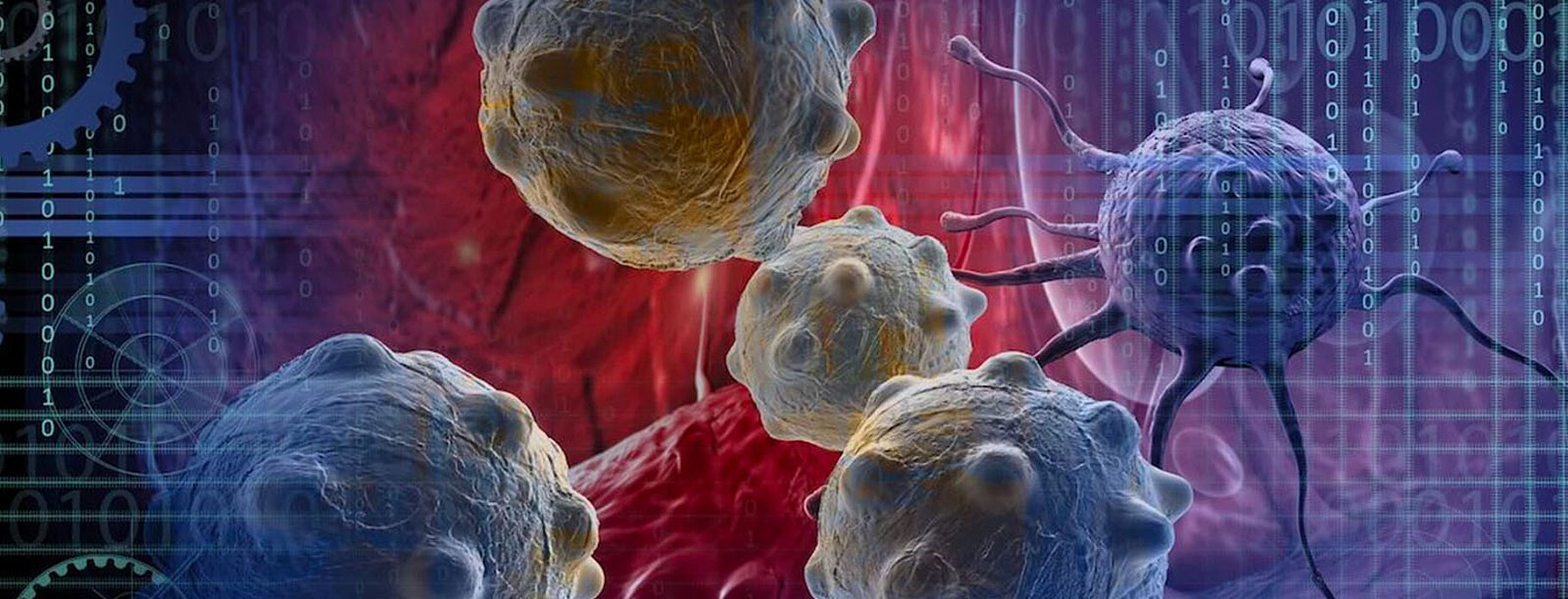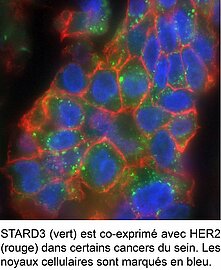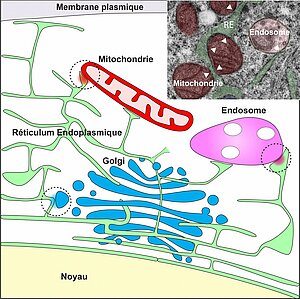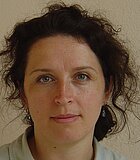
Molecular and cellular biology of breast cancer
Molecular and cellular biology of breast cancer
Our laboratory is interested in the cellular mechanisms deregulated in breast cancer.
Breast cancer is a heterogeneous disease with a high incidence. The fight against breast cancer presents challenges: tailoring cancer therapy to individual patients and identifying new therapies. The goals of our team are to understand how the deregulation of certain proteins and cellular functions in tumors impacts cancer growth and progression, and then use this knowledge to improve patient management.
The four main research areas developed in the team are:
- Characterization of the StAR related lipid transfer domain 3 (STARD3) protein which represents a vulnerability for HER2-positive breast cancers.
- Studying cellular structures called membrane contact sites that physically connect organelles.
- Determining the function of matrix metalloproteinase 11 (MMP11), a microenvironment protein involved in the tumor cell-breast adipocyte dialogue.
- The study of the link between environment and breast cancer.

Current projects
1: Molecular mechanisms of STARD3 addiction in HER2+ cancers
HER2 (Human Epidermal Receptor 2) is an oncogene activated by gene amplification in many cancers such as breast cancer (15-30%) and gastric cancer (10-30%). HER2 gene amplification leads to the co-amplification of several other genes including StAR related lipid transfer domain-3 (STARD3). The STARD3 gene has been identified in the laboratory and its expression correlates with that of HER2 in breast cancers suggesting that STARD3 plays a role in these cancers. Consistent with this idea, data from our lab and others show that inhibition of STARD3 expression results in a decrease of cell growth in all HER2+ cells, but has no effect on the growth of other cell lines.
The STARD3 gene encodes a protein that has no apparent link to HER2. STARD3 is a cholesterol transporter that acts at contact sites between the endoplasmic reticulum and endosomes.
Our project is to understand how this function of STARD3 promotes the growth of HER2+ cancer cells.
2: Inter-organelle contacts and lipid transport in cancer

Eukaryotic cells are compartmentalized into organelles, each with specialized functions. It has recently been recognized that the exchange of information and metabolites between organelles, in addition to vesicular transport, occurs at regions where the membranes of two distinct organelles come into contact in structures called membrane contact sites.
Our lab has shown that contact sites between endosomes and the endoplasmic reticulum (ER) created by the STARD3 protein (Alpy et al, 2013) enable cholesterol transport between these two organelles (Wilhelm et al, 2017).
The ER, which spans the entire cytoplasm of the cell, is a central in interorganelle communication mediated by contact sites. We have identified a receptor, named MOSPD2, localized on the surface of the ER, which enables the formation of contacts between the ER and many organelles such as endosomes, mitochondria etc... (Di Mattia et al, 2018). Recently, we have shown that the contact sites between the ER and other cellular organelles are regulated by phosphorylation.
Our project is to understand how contact sites are formed and regulated, and what their functions are in cancer cells.
3: Function of MMP11 in tumor metabolism
Matrix metalloproteinase 11 (MMP11) is a protein of the tumor microenvironment that is secreted by normal tumor cells (adipocytes and fibroblasts). Our work has shown that MMP11 participates in the communication between adipocytes and tumor cells, and modulates tumor metabolism.
Our project is to decipher the mechanism of action of MMP11 in the adipocyte-tumor cell dialogue.
4: Environment and breast cancer
Many epidemiological studies link the increase in breast cancer incidence to the environment. Some studies incriminate endocrine disruptors found in pesticides or even metals and present in our daily lives through foodstuffs, hygiene products, drinking water and the air we breathe. In order to know if there is a link between the environment and breast health, our research project, which is based on the Strasbourg breast tumor sample bank, is to measure various molecules (pesticides, metals) in the tumor and the peritumoral fatty tissue.
Publications
-
2004
-
Profiling trefoil factor family (TFF) expression in the mouse: identification of an antisense TFF1-related transcript in the kidney and liver
- Silvia C. Hertel
- Caroline E. Chwieralski
- Margitta Hinz
- Marie-Christine Rio
- Catherine Tomasetto
- Werner Hoffmann
Peptides ; Volume: 25 ; Page: 755-762
-
Urinary pS2/TFF1 levels in the management of hormonodependent breast carcinomas
- Marie Pierre Chenard
- Catherine Tomasetto
- Jean-Pierre Bellocq
- Marie-Christine Rio
Peptides ; Volume: 25 ; Page: 737-743
-
Trefoil factor 1 is required for the commitment programme of mouse oxyntic epithelial progenitors
- Sherif Mohamed Karam
- Catherine Tomasetto
- Marie-Christine Rio
Gut ; Volume: 53 ; Page: 1408-1415
-
-
2003
-
Dual stromelysin-3 function during natural mouse mammary tumor virus-ras tumor progression
- Kumari L. Andarawewa
- Anne Boulay
- Régis Masson
- Carole Mathelin
- Isabelle Stoll
- Catherine-Laure Tomasetto
- Marie-Pierre Chenard
- Martine Gintz
- Jean-Pierre Bellocq
- Marie-Christine Rio
Cancer Research ; Volume: 63 ; Page: 5844-5849
-
Cyclooxygenase-2 expression and effect of celecoxib in gastric adenomas of trefoil factor 1-deficient mice
- Kirsi Saukkonen
- Catherine Tomasetto
- Kirsi Narko
- Marie-Christine Rio
- Ari Ristimäki
Cancer Research ; Volume: 63 ; Page: 3032-3036
-
Metastatic lymph node 64 (MLN64), a gene overexpressed in breast cancers, is regulated by Sp/KLF transcription factors
- Fabien Alpy
- Anne Boulay
- Christel Moog-Lutz
- Kumari L. Andarawewa
- Sébastien Degot
- Isabelle Stoll
- Marie-Christine Rio
- Catherine Tomasetto
Oncogene ; Volume: 22 ; Page: 3770-3780
-
Two new peptides to improve post-operative gastric ileus in dog
- Louise Trudel
- Mickaël Bouin
- Catherine Tomasetto
- Pascal Eberling
- Serge A. St-Pierre
- P Bannon
- Marie-Claude l'Heureux
- Pierre Poitras
Peptides ; Volume: 24 ; Page: 531-534
-
-
2002
-
MENTHO, a MLN64 homologue devoid of the START domain
- Fabien Alpy
- Corinne Wendling
- Marie-Christine Rio
- Catherine Tomasetto
Journal of Biological Chemistry ; Volume: 277 ; Page: 50780-50787
-
Metastatic Lymph Node 51, a novel nucleo-cytoplasmic protein overexpressed in breast cancer
- Sébastien Degot
- Catherine H. Régnier
- Corinne Wendling
- Marie-Pierre Chenard
- Marie-Christine Rio
- Catherine Tomasetto
Oncogene ; Volume: 21 ; Page: 4422-4434
-
The trefoil factor 1 participates in gastrointestinal cell differentiation by delaying G1-S phase transition and reducing apoptosis
- Carine Bossenmeyer-Pourié
- Rama Kannan
- Stéphane Ribieras
- Corinne Wendling
- Isabelle Stoll
- Lars Thim
- Catherine Tomasetto
- Marie-Christine Rio
Journal of Cell Biology ; Volume: 157 ; Page: 761-770
-
Members
PhD students
Engineers
Trainees
Collaborations and networks
Guillaume Drin, IPMC, Valbonne FR
Jean Cavarelli, Alastair McEwen et Pierre Poussin-Courmontagne, IGBMC
Toshihide Kobayashi, Faculté de Pharmacie, Illkirch, FR
Jean-Michel Brunel, MCT, Marseille, FR
Yves Nominé, IGBMC
Rachid Thiam, ENS Paris, FR
Tim Levine, UCL, London, UK
News
![[Translate to English:] [Translate to English:]](/fileadmin/_processed_/2/6/csm_Mathlelin_0f70db3f93.jpg)
Carole Mathelin, first woman elected President of the French National Academy of Surgery
« I am enthusiastic about continuing the work of all those who have gone before me, by supporting, promoting and disseminating the excellence of…
Read more

